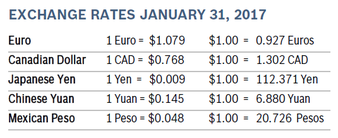|
All three indexes recorded gains for the month of January. The DOW closed above the 20,000 point level mid-month, but fell back the last week in January after some disappointing earnings and unease caused by many of the actions taken by President Trump during his first days in office. The DOW ended the month up 0.5% to 19,864, the NASDAQ closed at 5,614, up 4.3% and the S&P, the index most closely followed by economists, closed at 2,279, up 1.8% for the month. CONSUMER CONFIDENCE FALLS TO 111.8 The New-York based Conference Board’s Consumer Confidence Index fell to 111.8 in January after rising to a downwardly revised 113.3 in December. The Present Situation Index rose to 129.7 after dropping to a downwardly revised 123.5 in December. The Expectations Index fell into contraction at 99.8 after rising sharply to an upwardly revised 106.4 in December. Consumer confidence reached a 16-year high in December. The Conference Board says the decline was driven solely by a less optimistic outlook for business conditions, jobs and particularly consumers’ income prospect while consumers’ assessment of current conditions improved. Consumers remain confident that the economy will continue to expand in the coming months. Economists say a level of 90 indicates that the economy is on solid footing and a level of 100 or more indicates growth. Analysts caution that the real driver behind consumer spending is income growth and that labor market trends are a more accurate predictor of consumer behavior. CONSUMER SPENDING RISES 0.5% Consumer spending rose 0.5% in December after rising 0.2% in November. Core consumer spending, which is adjusted for inflation, increased 0.3% in December after rising 0.1% in November. Personal income rose 0.3% after rising an upwardly revised 0.1% in November, making for eleven consecutive months of gains. Consumer spending increased 3.8% in 2016 after rising 3.5% in 2015. With spending firming, inflation also showed some signs of picking up. In the 12 months through December the PCE price index advanced 1.6%, after increasing 1.4% in November. The core PCE price index, which is the Fed’s preferred measure of inflation, rose 0.1% in December after being unchanged in November and was up 1.7% in the 12 months through December. Consumer spending is closely watched by economists because it accounts for 70% of U.S. economic activity. CONSUMER PRICES RISE 0.3% The Consumer Price Index (CPI) rose 0.3% in December after rising 0.2% in November and 0.4% in October and was up 2.1% for all of 2016. It was the largest annual increase since a 3% rise in 2011. Prices rose 0.7% in 2015. Core inflation, which excludes food and energy, was up 0.2% in December and rose 2.2% for the year. In addition to falling energy costs, inflation has been kept low in recent years by the strong U.S. dollar that makes imports cheaper for U.S. consumers. Core inflation has been in a range between 2.1% and 2.3% since December of last year. The rising cost of gasoline was the biggest factor in the increase in the index. The price of Brent Crude has risen more than 90% in the past year, topping $50 a barrel in recent months. A shortage of affordable housing and rental properties is also driving up consumer prices. Energy costs rose 5.4% last year and medical care services rose 3.9%. If inflation stays steady or rises, it will strengthen the argument for the Fed to increase interest rates later this year. UNEMPLOYMENT RISES TO 4.8% The unemployment rate rose to 4.8% in January after rising to 4.7% in December and the economy added 227,000 new jobs, the biggest gain in four months and well ahead of economists’ expectations. However, job gains for December and November were revised down by a total of 39,000. Private employment rose by 237,000 and government employment fell by 10,000. For all of 2016, 2.24 million jobs were created. Wage growth remained slow, with average wages edging up just 0.1% and wages up 2.5% year-over-year. Construction added 36,000 new jobs, the biggest increase since last March. Retail payrolls increased by 45,900. Fed Chair Janet Yellen has said the economy needs to create just under 100,000 jobs a month to keep up with growth in the working-age population. DURABLE GOODS ORDERS FALL 0.4% Durable goods orders fell 0.4% in December after dropping a downwardly revised 4.8% in November. Economists had expected orders to increase 2.6%. Orders excluding transportation, which can be a highly volatile category, rose 0.5%, which beat economists’ expectations, but were down 0.3% for the full year. Capital goods orders for nondefense items excluding aircraft, which are seen as a proxy for business spending, increased 0.8% in December after rising an upwardly revised 1.5% in November. Shipments of non-defense capital goods excluding aircraft, which are used in the calculation of GDP, rose 1.0% in December after rising by an upwardly revised 0.6% in November. Durable goods orders fell 0.3% in 2016 compared to 2015. Growth in business investment lagged behind broader economic growth for most of last year, but investment accelerated in the fourth quarter. Economists expect that a more business-friendly environment in Washington will spur investment outlays this year. The durable goods report is often both volatile and subject to sharp revisions. CHICAGO PMI FALL TO 50.3 The Chicago PMI fell 3.6 points to 50.3 in January from a downwardly revised 53.9 in December 2016. It was the lowest reading for the PMI since May of last year, and down 8.4% compared to January 2016. Three of the five components fell, with only Order Backlogs and Supplier Deliveries gaining in January. New Orders fell by 7.8 points into contraction, and was at the lowest level since December 2015. Production fell 2.3 points to 56.0 in January. Order Backlogs rose but remained in contraction. Employment remained below the break-even level for the third consecutive month. Firms were asked what impact they expected from anticipated rate increases from the Fed this year. Nearly 9 out of every 10 respondents felt there wouldn't be much impact. Although the cost of capital is expected to increase, firms seem to have already factored that into their purchase decisions, according to MNI Indicators. The January reading marked the eighth month of expansionary business activity in the U.S. WHOLESALE PRICES RISE 0.3% The producer price index rose 0.3% in December after rising 0.4% in November. Wholesale prices were up 1.6% from December 2015, the largest year-over-year increase since September 2014. Energy prices rose 2.6% in December, as gasoline jumped 7.8%, accounting for almost half of the December rise in goods prices. Food costs rose 0.7%, the biggest increase since January 2015. Wholesale prices excluding food and energy rose 0.2% in December after rising 0.4% in November and were up 1.6% from December 2015. Services inflation eased, rising 0.1% in December after increasing 0.5% in November. Excluding food, energy and trade services, core producer prices rose 0.1% after climbing 0.2% in November. Core prices were up 1.7% from December 2015 after rising 1.8% year-over-year in November. The PPI for inputs to construction rose 0.7% in December after falling 0.3% in November and was up 2.4% from December 2015. Steady consumer demand and more stable commodity costs are expected to keep producer prices moving upwards; the strong dollar could moderate increases. Q4 GDP GROWS 1.9% GDP rose 1.9% in the fourth quarter and 1.6% for the entire year of 2016, below economists’ expectations and the worst showing in five years. GDP grew 2.6% in 2015. Home building and stronger business investment in both new equipment and research and development projects contributed to growth. Private inventories added a full percentage point to growth, but a wider trade deficit subtracted 1.7%. Consumer spending grew 2.5% in the fourth quarter with purchases of goods improving but purchases of services weak. The economy has not grown more than 3% since 2005. The nonpartisan Congressional Budget Office issued new GDP projections in January, and now projects that GDP will grow 2.3% this year and 1.9% in 2018. The agency said that structural trends, including baby boomer retirements, are driving a slowdown in economic growth compared with past decades. President Donald Trump has set a goal of doubling growth to 4% annually through an ambitious stimulus program of tax cuts, deregulation and infrastructure spending. Economists think 4% growth is very ambitious, but many have raised forecasts based on Trump’s stated policies and objectives, and some private economists now think GDP will grow 2.4% this year and 2.7% in 2018. Much uncertainly still surrounds what type of programs President Trump will be able to implement and what effect the new programs will have on the economy. JOB OPENINGS RISE Job openings rose by 71,000 to 5.52 million in November, up from a downwardly revised 5.45 million in October, according to the Job Openings and Labor Turnover Survey, or JOLTS. Hiring increased to 5.22 million from 5.16 million; the hiring rate was unchanged at 3.6%. The quits rate held at 2.1% for the sixth consecutive month, as some 3.06 million Americans quit their jobs, up from 3.02 million in October. Layoffs rose to a three-month high of 1.64 million, up from 1.57 million in October. The tight labor market is putting upward pressure on wages. There were 1.3 unemployed people vying for every opening in November, compared with 1.9 people when the recession began at the end of 2007. In the 12 months through November, the economy created a net 2.4 million jobs, representing 62.7 million hires and 60.3 million separations. The JOLTS report is one of Fed Chair Janet Yellen’s preferred economic indicators. © Robert Bosch Tool Corporation. All rights reserved, no copying or reproducing is permitted without prior written approval.
|
|








